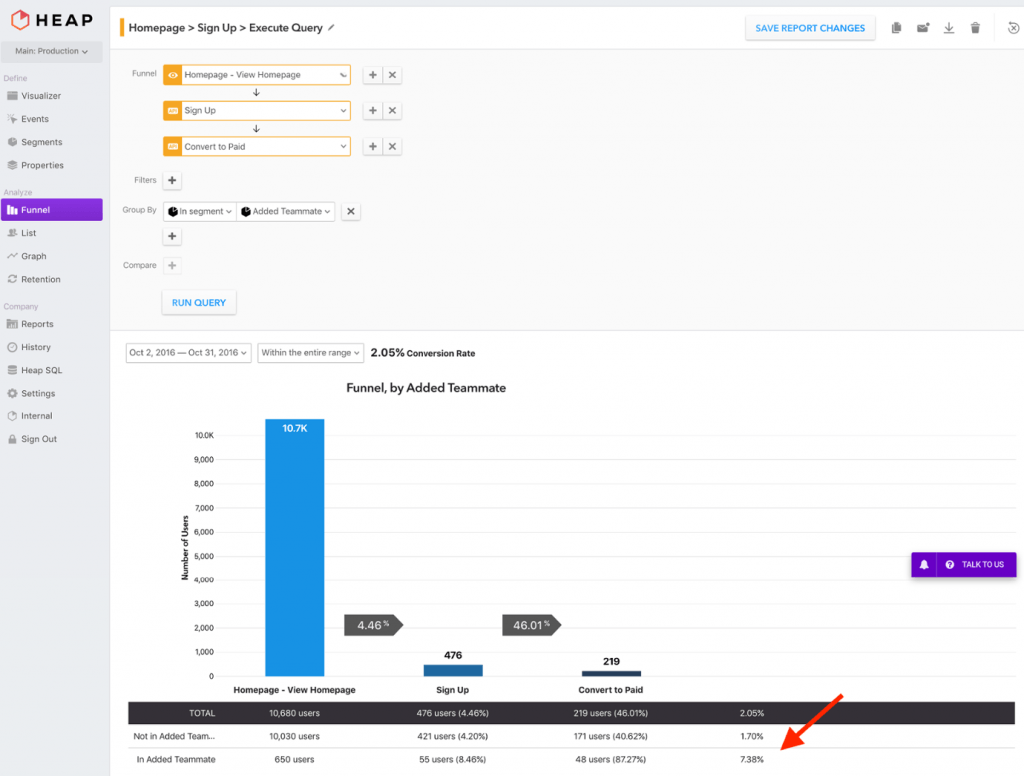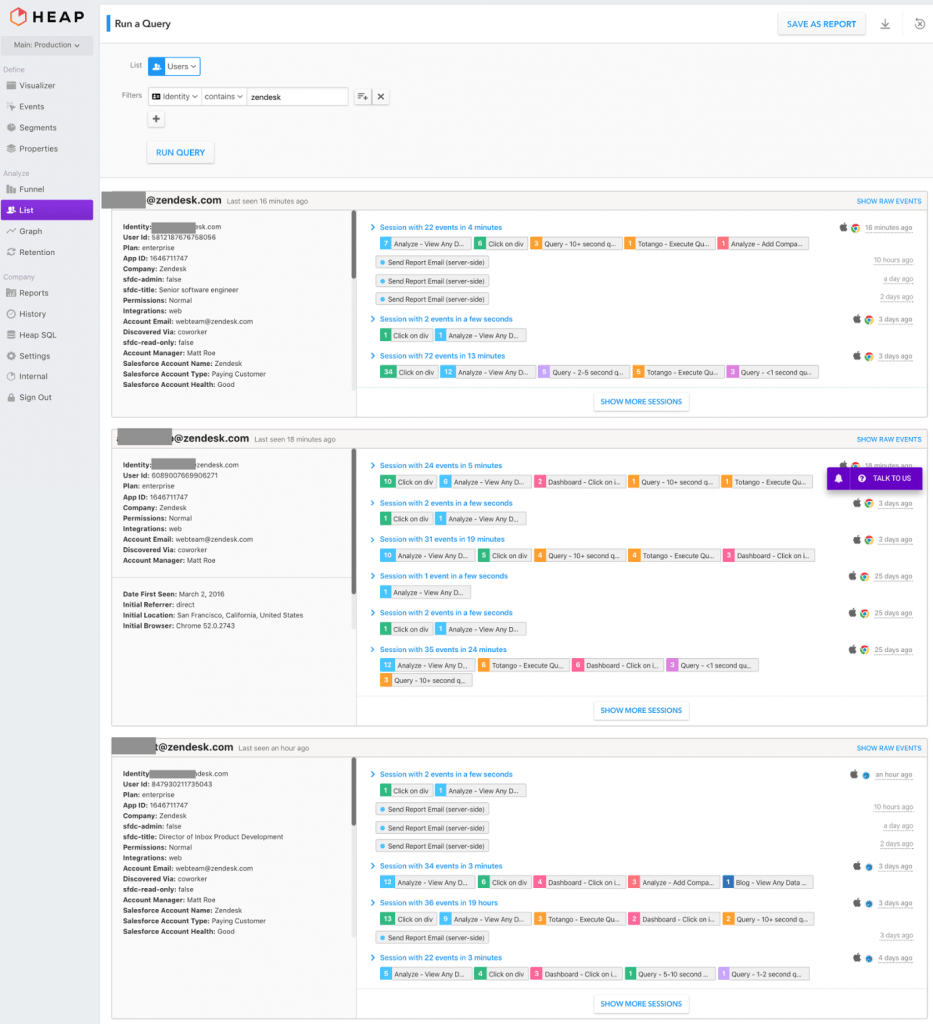Three Powerful Ways to Use Data to Close More Deals in SaaS Sales
As a salesperson, there are an unlimited number of tools that help us be successful. We use prospecting tools, Salesforce, LinkedIn, and email automation, but most of us aren’t taking advantage of the most powerful signals we have at our disposal: what our users are doing within our product.
Examining this behavior is critical, because regardless of whether you’re selling support software, an A/B testing tool, or a messaging platform, it’s our job as SaaS salespeople to act as consultants. We must provide timely, relevant information, and deliver a more trustworthy experience above and beyond that of our competitors.
With that in mind, there are three distinct ways you can use behavioral data to be more successful as a consultative SaaS salesperson.
Discover which actions influence conversion
You’ve successfully sold your product before, so you know which leads are likely to close. You know the best company profiles and buyer personas to target and when to target them. But do you know which prospect behaviors indicate likelihood to purchase, warranting immediate outreach?
Using your analytics tool (in our examples, we’ll use Heap), determine key conversion actions and guide prospects to perform those specific actions in your outreach. Is it when a prospect uses a specific feature? After they set up a certain template or report? When they engage with certain documentation? Using a funnel like the one below, you can easily find out what those key interactions are.

For example, for me, it’s important to make sure that I can help prospects see the full value of Heap. By analyzing how customers use our platform, we know that a prospect is more likely to use us if they’ve invited X number of teammates, ran Y number of queries, or created/shared Z number of reports.
During my first conversation with a prospect, I ensure they’re aware of these features, explain the value they’ll get by inviting their teammates, and share why it’s important to create a single, shared data source across the company. By looking into which actions influence conversion, I’m able to help my prospects get more value from the tool, and drive them towards paths of long-term engagement.
Improve your prospect’s experience by understanding their previous in-app/onsite interactions
How often do you get on a conference call and spend the first ten minutes diagnosing what your prospects have done so far, gathering feedback, and addressing concerns? Wouldn’t it be nice if you already knew these answers based on the actions your prospects take during their trial?
When looking at data, investigate how the prospect you’re meeting with is actually using your app. What are they clicking on? What are the pathways they’re taking? What content are they viewing? This allows you to spend your customer meetings adding value, challenging their thinking, and demonstrating how other key customers use you to achieve their concrete goals.
As an example, let’s say you sell A/B testing software. Usually, you might send a standard mid-trial check-in email that goes something like, “Hope you’re doing well, here’s {general collateral that may or may not be relevant to you and your needs}. Let’s talk.”

With insight into what that prospect is actually doing, you can now say, “Hey Mary Marketer, I understand that just you created your first button color experiment. It looks like it’s yielding significant results. Have you thought about also running a similar test with a different call-to-action in the shopping cart? A similar customer {insert reference} started using our product when experimenting with button colors, but really saw significant revenue lift with CTA experiments. Here’s a link to set that up.”
Isn’t that better?
This type of relevant and timely outreach helps you build credibility, trust, and rapport. Equally important, it allows you to drive the sales conversation, not because you’re a pushy salesperson, but because you’ve established yourself as an industry expert in your prospect’s mind. As a consultative SaaS salesperson, all three will improve your chances of closing more deals, building stronger relationships, and generating long-term customers.
Revive old opportunities or create upsell/cross-sell opportunities through segmenting
Let’s say you’re coming up on Q4 and your pipeline is looking weak. Rather than blasting your old lost opportunities with the usual “Ready to look at us again?” emails, why not use data to revive them?
When performing analysis, build a segment with prospects who signed up in the past, never converted to paying customers, and have returned to marketing pages. Then, customize your outreach accordingly.
For example, using Heap, I can see that an old prospect is starting to visit Heap again. Specifically, she’s engaging with new case studies and reading our blog. With this insight, instead of doing generic outreach based on how long she’s been a closed opportunity, I can offer to make an intro to the customer featured in that specific case study.

Beyond building pipeline, we all know how important up-sell/cross-sell is for SaaS businesses. How many of us have closed deals that were a lot smaller than we’d hoped? Maybe they only wanted a few licenses to start, or only wanted to use your product for a small, team-specific project or business unit.
Looking at your data, examine how they’re using you now. Are they taking certain actions that indicate they may be ready to use you in a new way? In Heap, for instance, if someone sets up email reports, downloads multiple CSVs, or browses certain documentation, that might mean they would benefit from expanding to more business units or upgrading their package to include our data-out functionality, Heap Connect. Using usage data in this way can help you grow your relationship with customers.
At the end of the day, buyers are increasingly smarter, more informed, and more technical. The more we can use data to be a better consultant and provide more relevant information for our customers during the sales cycle, the more successful we will be.
Learn how Heap can help
Want to use Heap to power your analysis, grow your pipeline, and build stronger relationships? Sign up for a free 14-day trial—installation only takes a few seconds. Or, schedule a demo with our sales team to learn more.
